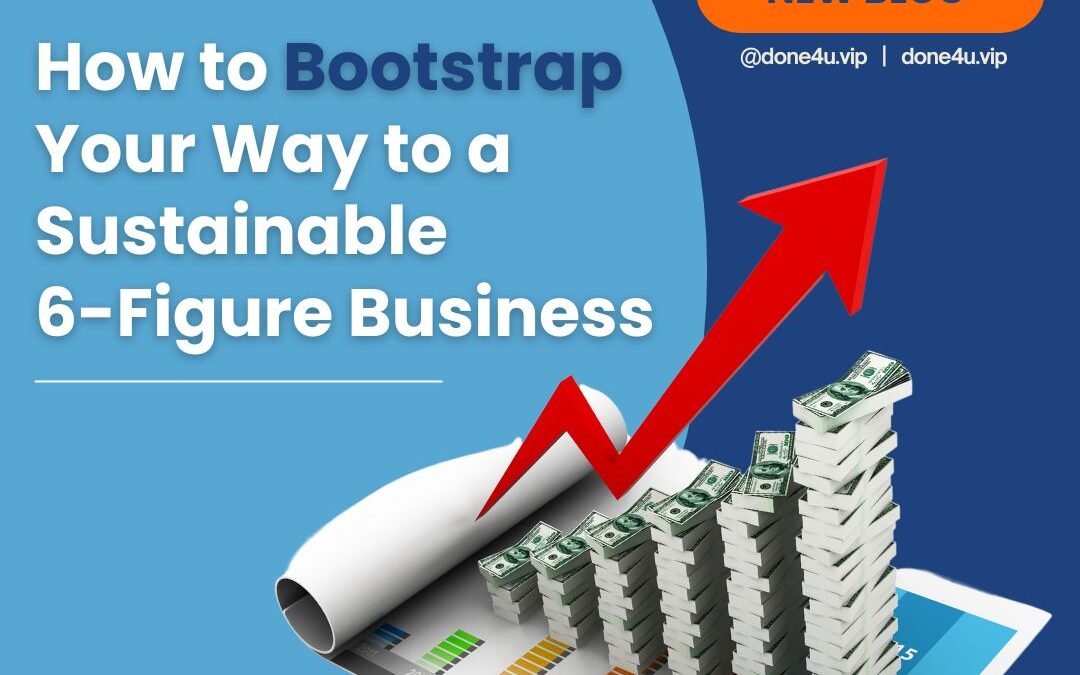Running a business in today’s challenging economy isn’t exactly a cakewalk. It requires ample resources to develop your products or services, gain a deep understanding of your target market, and ensure a steady flow of sales.
Scaling your business is still an achievable goal – and you don’t have to break the bank to do it.
Bootstrapping your business is a proven and reliable method of building a thriving company from the ground up.
When applied to established businesses, bootstrapping techniques have the potential to increase profits, foster growth, and allow companies to better succeed when the economy is in a slump. It’s not just limited to startup companies – even 6-figure businesses can benefit from adopting bootstrapping principles.
By understanding and implementing these principles, such as cost-cutting measures, reinvesting profits, and utilizing creativity, you can make a business venture more robust and resilient.
What Exactly Is Bootstrapping?
Bootstrapping is when and entrepreneur funds their startup or business’s growth without relying on external investments or capital. Instead, they use their personal finances or the new company’s operating revenues to sustain and fuel the business.
Established businesses often embrace bootstrapping as well, especially when they want to fund a new expansion, product offering, or hire more employees.
Importance of Bootstrapping
Bootstrapping allows you to focus on key business aspects, such as sales, marketing, and product development.
In addition, bootstrapping can make your business more sustainable. By minimizing unnecessary expenses, you can increase the company’s efficiency and profitability.
Embracing a bootstrapping mindset pushes you to think creatively and be lean, ultimately guiding your business toward long-term success.
Steps to Bootstrap a Business to 6 or 7 Figures
1. Keep Costs Minimal
Being frugal without compromising quality or efficiency is key. Keep costs low by using a home office instead of a rented brick-and-mortar space. Utilize free online resources to conduct business when possible. If you have an online business, only purchase the apps and software that you actually need avoiding shiny object syndrome. Automate tasks wherever you can.
2. Focus on Profits
Take an honest look at your pricing strategy to ensure you have an accurate and healthy profit margin. Focus on projects and retainer clients that bring in the most revenue while doing the work that you excel in.
3. Organic Marketing Channels
Use SEO-optimized blog posts, social media, and personal connections to market your business projects in efficient, cost-effective ways. Build relationships.
4. Hone in on Your Target Market
As much as we like to think so, our target market isn’t everyone. Determine who your target market is and really hone in on that market and serve your clients well. Provide value. Bootstrapping is a slow game, so you must offer the right package with excellent service. You’ve got to stand out to your audience in a way that benefits them. Again, show them your value. Always provide more than they expect to get.
Success and business growth in bootstrapping isn’t going to happen overnight, so set realistic goals and remain patient and persistent throughout the journey.
Bootstrapping Vs Venture Capital
Bootstrapping allows you to fund your own business with your own savings or through profit gained by the business itself, maintain full control over the business and its decisions, and run it at your own pace. One article states that 80% of startups are self-funded with an average growth rate of 20% per year.
On the other hand, venture capital (VC) funding involves external investors who provide capital in exchange for equity in the business. You can scale the business at a faster rate, but it comes at a cost. You’re then sharing control, and it can be time-consuming and stressful.
However, VC investors can often bring valuable expertise, industry connections, and mentorship to the table.
Ultimately, the choice depends on your specific business goals, the industry you’re in, and the level of growth you’re looking to achieve within a time frame.
Advantages of Bootstrapping
1. Full Ownership of the Company
Since you’re not relying on outside investors, you retain complete control over the direction and decision-making process.
2. Strong Sense of Financial Discipline
When you have limited resources, you learn to carefully budget and prioritize spending on what truly matters for your company’s success – value and quality service that leads to customer satisfaction.
3. Strong Company Culture
Without the pressure of external investors, you can instill values, set long-term goals, and create an environment where your team takes pride in their work.
Disadvantages of Bootstrapping
1. Financial Risk
When bootstrapping, you’re using your own savings or business profits to fund the business. If the company faces any setbacks, like slow sales or unforeseen expenses, it directly impacts your personal finances.
If you’re in a situation where some of your business profits must be used for personal expenses, that’s a more difficult situation and your business will grow at a much slower pace because you have less money to invest. In fact, that the situation I was in when I started my business. I was a single mother, supporting my family of three with all of the earnings from my new business. Plus, I quit my job way too early. I should’ve waited a year. I laugh about it now, but my first August of being an entreprenuer, both of my two clients went on vacation – one for a month and one for two weeks! I was hourly way back thing so I was left with minimal revenue for a month, and as you can imagine, I was scrambling.
2. Limited Resources
You might not be able to hire the talent you need or invest in more advanced tools and technology to improve your business. This means you’ll be wearing all the hats for a longer period of time. This can lead to burnout and more time away from family.
Bootstrapping Practices to Scale Your Business
By staying cash-flow positive, you can better reinvest in your business. This helps you to grow at a steady pace and minimize debt. About business debt, keep in mind that when you build your business on credit cards, interest rates eat into your revenue and profits. Focus on revenue-generating projects and clients. This doesn’t mean that you’ll never sign on with a client that produces less revenue. You likely will. If you support growth within that company, they will ultimately become a higher revenue client.
Maintain tight control over expenses. Keep your overhead low and continually evaluate your business processes for efficiency. Finding low-cost alternatives to pricey tools and software also makes a huge difference.
Forming strategic alliances with other businesses and individuals in your industry allows you to leverage shared resources and expand your reach. Attend industry events, join online forums, and seek out mentorships to establish new connections. Join your local chamber of commerce.
Wrap-Up: Bootstrapping Your Business
Bootstrapping offers a unique (and common) pathway to launch, grow, and sustain your business. It not only nurtures the entrepreneurial spirit of creativity and resourcefulness but also paves the way for making informed decisions that contribute to your company’s long-term financial success.
Interested in learning more? Schedule a complementary 30-minute Zoom call with Done4U Virtual to discuss cost-effective and efficient bootstrapping strategies you can use to scale your business to 6-figure success.


